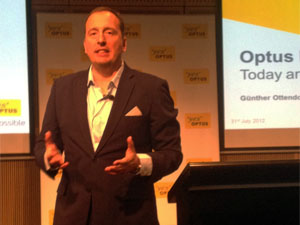Optus launches 4G in Sydney, Perth

Optus has today launched long-term evolution (LTE) services in Sydney and Perth for business customers, following the completion of upgrades to its 3G network in those areas.

(Credit: Josh Taylor/ZDNet )
The move into Sydney and Perth expands Optus' 4G roll-out to 500 tower sites across the country, including the trial roll-out in Newcastle in April. Optus has chosen two vendors for the roll-out: Nokia Siemens Network was picked for the Sydney and Perth roll-out, while Chinese network giant Huawei was picked for the Melbourne roll-out, which is due to come online at the end of August when 3G upgrades are completed there. This will bring the total number of 4G towers up to 600.
Optus will also launch services to small business, enterprise and government customers in Sydney and Perth. Existing trial customers in Newcastle will be migrated over to the new business plans once Optus implements a packet core switch in Newcastle by 13 August.
The Sydney 4G network covers approximately 10km of the CBD, ranging from Linfield in the north to Botany Bay in the south. The Perth coverage is 20km from east to west of the Perth CBD, and 15km from north to south.
Optus has launched two Huawei devices for customers: a standard 4G USB dongle and a Wi-Fi hotspot that can connect up to five devices to Optus' 4G network.
The plans come in three varieties: 10GB per month, 15GB per month and 20GB per month, either on 12- or 24-month contracts. Prices range from AU$40.45 per month up to AU$89.45 per month.
(Credit: Optus)
A 4G roll-out in Brisbane will happen once the 3G upgrades have been completed at the end of the year, and Adelaide's turn will come next year.
Since making the upgrade announcement in September 2011, Optus has also upgraded more than 1000 3G mobile sites to use re-farmed 900MHz spectrum for HSPA+ services.
Optus' managing director of networks Günther Ottendorfer told journalists at Optus' campus in North Ryde today that when the upgrades were rolled out, Optus noticed an immediate 12 per cent spike in data volumes on the network in those upgraded areas, and it kept growing.
"It was not a one-off. If we look at how this developed since then, you will see that since then, we have seen the data traffic increase in those two clusters of about 30 per cent. And that's the combined traffic of 3G and 2G," he said.
"What we have learned from that is that our customers are using it, they're using the opportunity to have this better indoor coverage [with 900MHz]."
(Credit: Josh Taylor/ZDNet)
While he noted that indoor coverage and coverage on motorways has improved thanks to the re-farming of the 900MHz spectrum, he said that networks will always have congestion.
"At the end of the day, mobile networks is a mobile network, so there will always be some problems, but with the energy we put into this, we have certainly improved our network quite a lot."
Following the acquisition of Vividwireless and its associated 2.3GHz spectrum for AU$230 million in February, Optus has, since last week, been using that spectrum to test time-division duplex (TDD) LTE technology — whereas the rest of Optus' 4G is frequency division duplex (FDD) LTE. Optus has one tower set up in the Sydney western suburbs town of St Mary's, and one located at the Optus campus in North Ryde.
Ottendorfer said that the tests have so far yielded download speeds of up to 250 megabits per second (Mbps), with an average per-user range of speeds between 25Mbps and 87Mbps.
Supplementing FDD LTE networks with TDD is the future, he said, because 10 per cent of LTE launches today are TDD LTE, and multimode and multiband chipsets that will be able to handle both types of LTE are now being produced.
"This ecosystem is developing really quick. We're excited to be part of that, and we think that is a 4G world full of opportunities for us."
Ottendorfer said that the future roll-out will depend on customer demand, but could also be impacted by the Federal Government's intention to release the digital dividend spectrum.
Rival telco Telstra has more than 100 4G sites across Australia, while Vodafone has committed to launching 4G services in 2013.